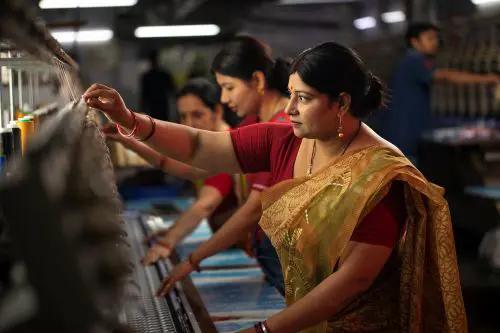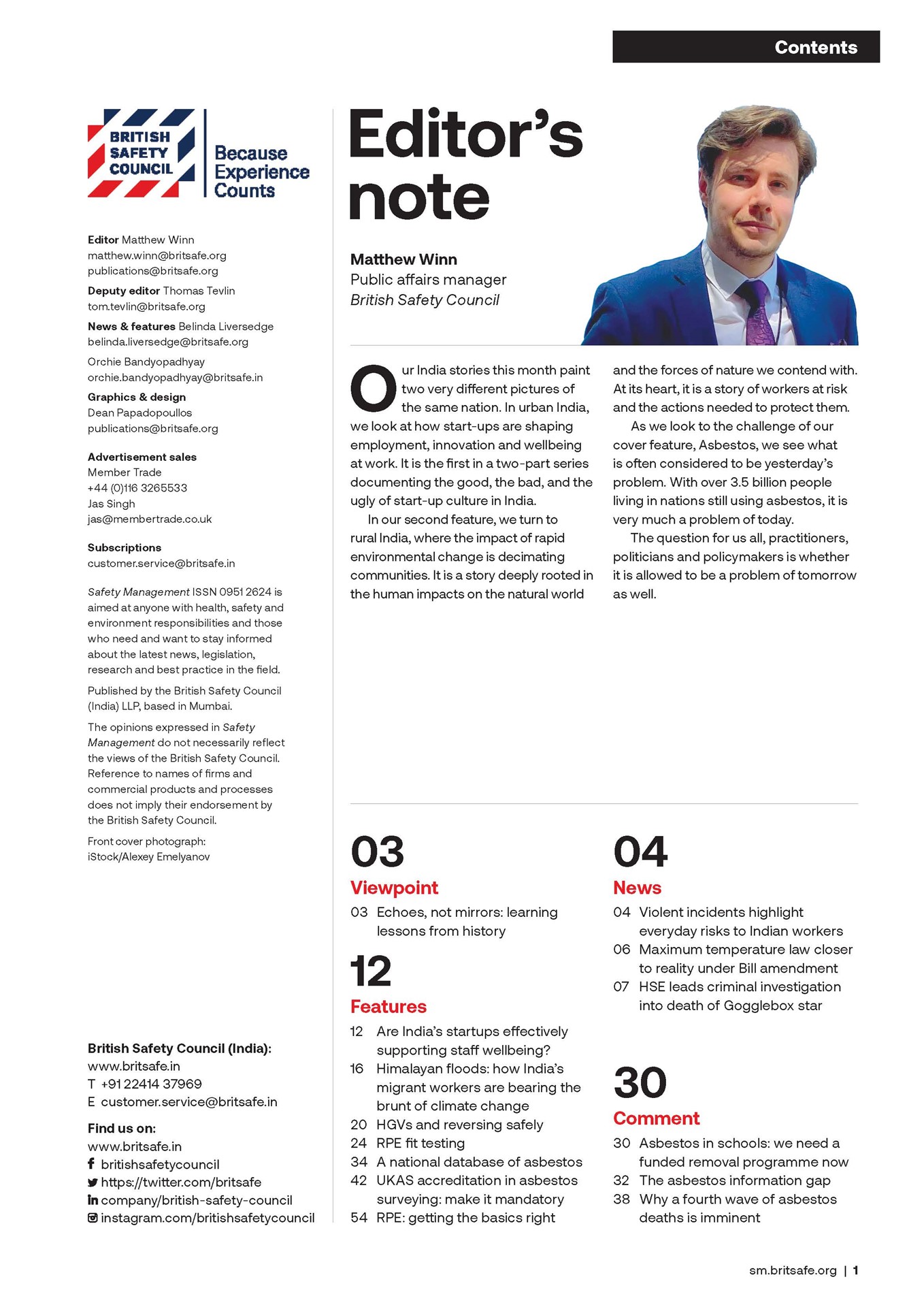Despite government efforts to construct hundreds of millions of toilets across India in recent years, female workers in informal sectors like street vending, construction and agriculture still struggle to find safe and clean sanitary facilities, restricting their earning power and placing their health at risk.
Features
Toilet trouble: how India’s working women still lack suitable facilities
In India, women have undeniably made remarkable progress in various professional fields, breaking barriers and scaling new heights both professionally and personally. However, their journey towards playing a full role in the world of work – and gaining equal access to the same employment and professional opportunities as men – continues to be fraught with challenges.
According to the 2011 Indian Census figures, there are 587 million women in India, accounting for 48 per cent of the population. Despite this, only one third of women have joined the labour force.

The latest Periodic Labour Force Survey for 2021–22 highlights that the female labour force participation (FLFPR) for the prime working age group of 15 years and above stood at 32.8 per cent in India, despite females accounting for almost half of the population.
Women seeking to secure work and advance in various fields of employment must balance their career goals with considerations such as societal expectations and familial responsibilities, which adds a layer of complexity to a working woman’s life. Women, who are often the primary carers for children and parents within the family unit, find their work-life balance disrupted, particularly when extended working hours clash with the demands of unpaid work at home, such as childcare and household tasks.
A 2024 International Labour Organisation (ILO) report, The impact of care responsibilities on women’s labour participation, echoes this concern. The researchers found that 53 per cent of women in India are unable to participate in the labour force due to care responsibilities, and called for further investment in the care economy to remove barriers preventing women from seeking employment. The report’s recommendations included greater government funding to expand the availability of formal care facilities for children, the elderly and people with disabilities, to relieve women of some of their caring responsibilities.
Alongside care commitments, there are a number of other barriers preventing women from fully participating in the workforce and gaining access to the same employment opportunities as men, such as the gender pay gap and sexual harassment.
Absence of toilets
However, one critical – yet under-explored and often unrecognised barrier – is the absence of proper toilet facilities.
Although several studies have been conducted into how unpaid care responsibilities and household tasks are preventing women from entering the world of work and limiting the economic potential of those females who are in employment, there is a noticeable gap in research examining how access to basic public sanitation infrastructure influences female participation in India’s labour force.
In fact, most working woman in India can likely recount at least one experience where they found themselves facing inadequate, poorly designed, ill maintained or entirely non-existent toilet facilities, both at work and in public locations.
Women say that the lack of access to a toilet influences workplace psychology. “To avoid trips to the toilet, some women deliberately avoid hydrating, risking health issues like urinary tract infections (UTIs) and dehydration,” says HR consultant Sneha Yadav.
Dr Rachana (who only goes by her first name), a gynaecologist, warns that failing to drink liquids in a bid to avoid the need to urinate poses a serious health risk to women: “Frequent urination is essential to flush out harmful bacteria from the body, thereby reducing the risk of health problems such as UTIs,” she says.
The lack of access to suitable toilets and sanitation facilities is a particularly serious problem in the informal sector, warn activists. According to India’s National Sample Survey, the proportion of working women in urban areas has increased from 11.9 per cent in 2001 to 15.4 per cent in 2011. Experts say that in recent years, one of the fastest-growing sectors for the employment of women in urban areas has been domestic work, with an additional 1.5 million urban women joining the sector in the last 10 years.
However, domestic work – which includes tasks such as cleaning, cooking and some childcare roles – falls into the category of informal or unorganised work, which is typically untaxed, unregulated and lacks government oversight. These workers have few workplace rights, warn activists.
Domestic workers banned from using toilets
In a social media post, Smita Ram, co-founder & CEO of Rang De, an online platform that allows socially-minded investors to loan money to entrepreneurs and students in low-income households, stated: “In India, many domestic workers are not allowed to use the bathrooms they clean. To avoid this situation, they are explicitly told not to drink water while at work. Domestic workers simply end up waiting until they get home, which could be eight hours away. Most of them are women.
“The result? Urinary tract infections, dehydration, shame and a complete erasure of bodily dignity. And the worst part? It is normalised and has become part of our culture.
“And this isn’t just about domestic workers, even construction workers face the same [challenges]. Working long shifts in dusty, sun-scorched sites, without toilets, shade and water, they don’t hydrate – not because they don’t want to, but because they can’t afford to.
“While we speak of development, what about the dignity of these workers? Why is drinking water still a luxury?”
Other commentators have warned that approaches such as women avoiding drinking liquids and trying to hold their urine due to the lack of suitable and nearby sanitary facilities can cause other health problems, like constipation and stomach cramps and aches.
According to some estimates, one-third of India’s 40 million street vendors are women, and 30 per cent of informal construction workers are female. For these workers, taking time away from their vending carts or from a construction site to look for a safe place to relieve themselves means reducing their output and risking lost wages.
The problem also extends to the agricultural sector, where women are often employed as labourers and harvesters. One woman sugarcane cutter who has worked in Maharashtra and Andhra Pradesh states that she has never seen a toilet or bathroom provided for women toiling as farm labourers.
“Men can go behind the bushes anytime of the day or night to ease themselves or walk to the nearest pond or lake and bathe but we cannot do the same,” she explains. “Early in the morning, when it is still dark, we go into dense sugarcane fields to finish our morning rituals. We do fear slipping or being bitten by insects along the trek, but this is how it has been for years and there will be no change.”
The woman, named Sunita, added that she was unable to take a bath for weeks while working in the sugarcane fields.
Disruption to working life
In the National Capital Region (NCR) of Delhi, street food vendors are overwhelmingly female. These women operate in public spaces, but poor access to basic public sanitary facilities, such as clean water and toilets, often disrupts their working lives.
Anita Juneja, a 42-year-old street food vendor in the busy Lajpat Nagar neighbourhood of Delhi, says: “I chose vending because it required little capital or education. I set up my stall at 11.00am and pack up by 8.30pm. I have to sit in the hot scorching sun for hours to sell my ‘Momos’ (steamed dumplings). Many days, especially in summer, I suffer from severe headaches and migraines. I have to buy a 25-litre water drum daily.”
When Anita needs the toilet, she heads to a nearby shopping mall, but she admits: “Trips to the toilet and water delivery cut into my already meagre earnings so I try to avoid these as far as possible.”
Juneja, who has worked as a street vendor for over a decade, says: “It is not easy to work as a street vendor as one faces problems with the local authorities, police and goons (aggressive members of the public, particularly men).” As a result, she is regularly forced to change the location of her stall.
“The government says we are on path to becoming the third largest economy, but I do not see any significant change happening,” she argues. “Although I want things to change for the better, I know for real change to happen, vendors like me should also be given a voice in key decision-making processes affecting our lives.
Only then can we think of measuring and achieving meaningful progress. Let’s begin with basics like access to clean drinking water, loos and education, among others.”
Although there appears to be limited recent research on the level of provision of adequate toilets for men and women in locations such as Delhi–NCR, a 2017 survey by ActionAid India found that 35 per cent of public toilets in Delhi did not have a separate section for women
Out of 229 toilets surveyed, 149 had some provisions for women, and there were also concerns about issues like inadequate cleanliness, poor hygiene and safety measures, all of which are known to deter women from using public toilets.
The researchers found that over 66 per cent of the female toilets surveyed lacked a working flush, 53 per cent had no running water and more than 51 per cent did not include a facility for hand washing. Additionally, there was no soap available in around 61 per cent, which again highlights concerns about the quality of public sanitation available for women.
Structural and safety issues were equally alarming. About 28 per cent of the toilets had no doors and 45 per cent lacked a functional lock from inside. More than half had no lighting, either within the toilet cubicles or in the surrounding premises or toilet block. Alarmingly, nearly half (46 per cent) of the toilets were unguarded, reflecting a stark absence of basic security measures and raising serious concerns about the safety of women using these facilities.
Risk to health
Commentators say that, while poor toilet provision for female workers poses a major inconvenience for women seeking a safe and clean sanitary facility, it can also be a risk to health.
Climanosco, an independent non-profit association that publishes academic articles on climate science, surveyed 312 women working in informal sectors, such as agriculture and brick and steel manufacturing, in southern India during 2014–2016. The survey found that nearly 64 per cent of the women did not have access to toilet facilities at their workplaces, and there was a direct association between women reporting heat-related health symptoms and a lack of access to toilets at work. 87 per cent of working women reported that they experience specific urinary and genital infections periodically, and the women without access to toilets reportedly had a six times higher risk of having urinary and genital infections.
The researchers also found that women who were ‘not drinking sufficient water’ had four times the risk of developing genito-urinary issues compared with women ‘drinking sufficient water’. This is an important finding as many female workers in India report attempting to cope with the lack of access to nearby, adequate and safe toilet facilities while at work by not drinking any liquids before or during their shifts.
The report further stated that interventions, such as improving sanitary facilities at work and reducing workers’ heat exposure using simple techniques, could help reduce health risks to low-income workers.
Activists warn that low income and low skilled workers are among those facing the greatest health risks from poor access to toilets and exposure to high temperatures – for example, in agriculture, construction and outdoor vending work.
However, although a lack of access to adequate toilet and sanitary facilities is most common in the informal sectors of the economy, even women in professional roles are not immune. A young female journalist at a leading daily newspaper in India newspaper says she avoids drinking water on assignment due to the poor state of public toilets. “It’s shocking how normalised this is. Whether I’m a reporter or a farm labourer, when nature calls, it’s under the open sky,” she laments.
FEATURES

The price of fast fashion is not pretty
By Orchie Bandyopadhyay on 11 December 2025
The largely female workforce in India’s garment manufacturing industry faces long hours, low wages and poor working conditions, and campaigners say it is time the Indian government and international clothing brands took tougher action to improve working conditions, pay and employment rights.

Suicide at work: a major problem in India
By Orchie Bandyopadhyay on 11 December 2025
Recent reports of suicides among workers ranging from police officers to electoral roll officials have prompted calls for employers and government agencies to do more to both reduce excessive workloads and provide better mental health support at work.



